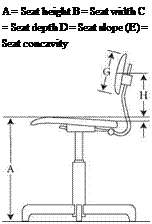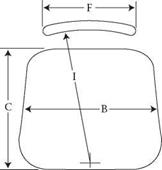Standing for long periods causes fatigue, reduces performance, and is especially stressful for those workers with physical foot, leg, hip, or back problems. Such people are dependent on some form of supporting surface to relieve fatiguing and troublesome loading on the body. Supporting surfaces for sitting are the most common (see Figure 6.8). From a physiological standpoint, chairs should be designed so as not to cause pressure on the underside of the thigh. The weight of the body should be taken mainly on the ischial tuberosities, the bony points on either side of the base of the spine. This will avoid pressure on the underside of the thigh that results in a reduction in blood circulation in the legs, and numbs the large nerves that travel down the back of the legs. The resultant circulatory difficulties cause the legs and feet to ‘go to sleep’. Pressure on the underside of the thigh can be avoided by making the chair sufficiently low, and reducing the degree of backwards slope of the seat. The chair should not, however, be so low that it causes pressure on the base of the spine. The height should be adjustable so that the chair gives suitable support to the tuberosities.
A chair should also be designed so that it gives suitable support to the back (particularly the small of the back). The support should not be so great that it hinders the movements of the arms and spine. The support should be concave in the horizontal planes and convex in the vertical plane. The back rest gives rise to a force that attempts to push the sitter out of his chair, and this may mean that the sitting person
 |
 |
F = Backrest width G = Backrest height H = Backrest centre height I = Backrest radius
FIGURE 6.8 Vital measurements for a work chair. (E) Note: The concavity of the seat cannot be seen in the figure.
has to resist this force with the aid of the leg muscles; this in turn produces a static loading on the leg muscles. These static muscle forces can be prevented by means of a suitable backward sloping of the chair seat and sufficient friction on the seat.
A basic feature for comfortable sitting is that the chair must have a high coefficient of stability—that is, a high resistance to tipping over—which means that the base should be as wide as possible. If the floor is uneven, the chair should be adjustable, for example, by the use of screwed feet. Preferably, the floor should be level and evenly surfaced.
The supporting surfaces that we use may be categorised according to the function they fulfil. These functions can be divided into the following:
1. Resting surfaces (e. g., bed)
2. Looking/listening functions (e. g., TV armchair)
3. Working function (including looking, listening, speaking and working with objects; this may be occasional or full-time)
4. Special work (e. g., footstools)



